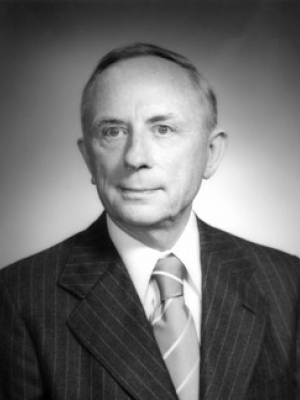Walter Gordy was one of the founding fathers of microwave spectroscopy, and his research laboratory became world famous soon after his arrival at Duke in 1946. Besides conducting pioneering and innovative research he inspired and mentored a large number of graduate students and research associates.
Gordy was born on April 20, 1909 in rural Newton County, Mississippi, and was reared on a farm. After one year attending Clarke Memorial Junior College, he entered Mississippi College in 1930, graduating after only two years with “special distinction”. He enrolled at the University of North Carolina in Chapel Hill, and received already in 1935 his P.hD .under the direction of Earle K. Plyler doing infra-red spectroscopy work. From 1935 until 1941 he taught at Mary-Hardin-Baylor College in Belton, Texas, then a women’s college. During the summers, Gordy traveled to the University of North Carolina and to Ohio State University using their infrared spectroscopic facilities to pursue his interest in spectroscopic studies of hydrogen bonding.
His hard work was recognized by the award of one of just two National Research Fellowships given in physics in 1941 to work in the laboratory of Linus Pauling at the California Institute of Technology. In 1942 his fellowship tenure was interrupted by World War II and he joined the staff of the MIT Radiation Laboratory where he participated in the development of microwave radar. This activity was vital to his future research in molecular spectroscopy.
In 1946 Gordy was appointed on the Physics faculty of Duke University and rose to the highest rank, James B. Duke Professor in 1958. In recognition to his outstanding research, he was elected to the National Academy of Sciences in 1964, and received several prestigious recognitions: the State of North Carolina Award for Science, the Jesse Beams Award and the E.K. Plyler Prize for molecular spectroscopy, these two prizes distributed by the American Physical Society. Furthermore he received the 50th Anniversary Award of the Mississippi Academy of Sciences and the distinguished alumni award of the University of North Carolina. He retired from Duke in 1979, and then worked intensively on a second edition of his book on microwave spectroscopy, finishing it a year before his death in 1985.
On his transfer from the MIT Radiation Laboratory to Duke University, Gordy brought with him a large quantity of government surplus K-band radar components, which enabled the rapid creation of the Duke Microwave Laboratory. During his scientific activity there, he developed the field of microwave spectroscopy and expanded into the range of millimeter and submillimeter molecular spectroscopy. He also conducted extensive research into electron spin resonance and applied these techniques to biological problems, hence becoming one of the pioneers in biophysics. With his techniques he studied radiation in first amorphous and later crystalline organic and biological materials. At Duke, Gordy supervised the PhD. theses of 75 students, he wrote 4 monographs and published more than 250 scientific articles. He reacted promptly to inquiries from potential postdoctoral associates, often from abroad, and was successful in attracting to his group a number of outstanding young scientists. One of the early ones was Hans G. Dehmelt, who later won a Nobel Prize in physics for his work at the University of Washington. Gordy’s extensive collection of papers and correspondence is available at the Duke Special Collections Library.
Gordy’s scientific legacy has been in the foundations he laid for science and technology in the millimeter and submillimeter spectral region (1011 – 1013 Hertz or 3mm –0.03 mm wavelength). He stimulated advances and exploited them in new techniques, such as the harmonic generation technique for the study of rotational spectra of small fundamental molecules. His research led to enduring technological advances in high frequency generation sources and detectors. These aspects are described in detail in the biography of Gordy for the National Academy of Sciences.
Gordy’s family life was a very happy one. During his studies in Chapel Hill he met his future wife, Vida Miller, an English instructor, whom he married in 1935. They both moved to Texas that year and Vida taught Latin at the Mary Hardin-Baylor College where Gordy was a Physics professor. At Duke she was an invaluable partner in Gordy’s scientific life. As a former English instructor, she edited the PhD theses, helped to make sure that the scientific content of papers and theses was clearly presented and in a syntactically correct style. She was a generous and devoted host and advisor to the many members of the microwave group, and was beloved for her sweet personality and highly respected for being such an important asset in the group’s research. She was a true Lady, just as Gordy was a Southern gentleman. Their two children, Terence and Eileen were raised in Durham.
*This short piece is adapted from the detailed biography of Walter Gordy written by his former students Frank C. De Lucia and Brenda P. Winnewisser for the archives of the National Academy of Sciences. It contains a collection of interesting stories about Gordy and describes in detail his scientific legacy and impact on the field of spectroscopy. A short biography is also found on the Ohio State University webpage.





